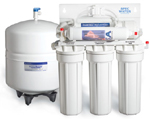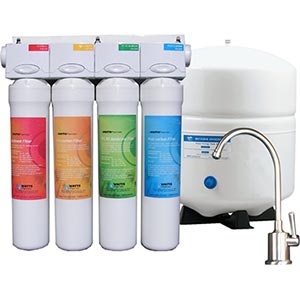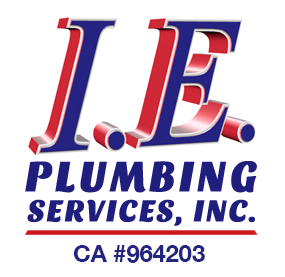Reverse Osmosis System
Bad Tasting Water?
Reverse Osmosis Systems
 Reverse osmosis is sometimes referred to as ultra-filtration because it involves the movement of water through a membrane as shown in Figure 1. The membrane has microscopic openings that allow water molecules, but not larger compounds, to pass through. Some RO membranes also have an electrical charge that helps in rejecting some chemicals at the membrane surface. Proper maintenance is essential to retain effectiveness over time. Some units are equipped with automatic membrane flushing systems to clean the membrane.
Reverse osmosis is sometimes referred to as ultra-filtration because it involves the movement of water through a membrane as shown in Figure 1. The membrane has microscopic openings that allow water molecules, but not larger compounds, to pass through. Some RO membranes also have an electrical charge that helps in rejecting some chemicals at the membrane surface. Proper maintenance is essential to retain effectiveness over time. Some units are equipped with automatic membrane flushing systems to clean the membrane.
What Impurities will Reverse Osmosis Remove?
Reverse osmosis (RO) has become a common method for the treatment of household drinking water supplies. Effectiveness of RO units depends on initial levels of contamination and water pressure. RO treatment may be used to reduce the levels of:
- Naturally occurring substances that cause water supplies to be unhealthy or unappealing (foul tastes, smells or colors).
- Substances that have contaminated the water supply resulting in possible adverse health effects or decreased desirability.
- RO systems are typically used to reduce the levels of total dissolved solids and suspended matter.
 The reverse osmosis process contains several downsides which make it an inefficient and ineffective means of purifying drinking water. The small pores in the membrane block particles of large molecular structure like salt, but more dangerous chemicals like pesticides, herbicides, and chlorine are molecularly smaller than water (Binnie et al, 2002). These chemicals can freely pass through the porous membrane. For this reason, a carbon filter must be used as a complimentary measure to provide safe drinking water from the reverse osmosis process. Such chemicals are the major contaminants of drinking water after municipal treatment.
The reverse osmosis process contains several downsides which make it an inefficient and ineffective means of purifying drinking water. The small pores in the membrane block particles of large molecular structure like salt, but more dangerous chemicals like pesticides, herbicides, and chlorine are molecularly smaller than water (Binnie et al, 2002). These chemicals can freely pass through the porous membrane. For this reason, a carbon filter must be used as a complimentary measure to provide safe drinking water from the reverse osmosis process. Such chemicals are the major contaminants of drinking water after municipal treatment.
Another downside to reverse osmosis as a method of purifying drinking water is the removal of healthy, naturally occurring minerals in water. The membrane of a reverse osmosis system is impermeable to natural trace minerals. These minerals not only provide a good taste to water, but they also serve a vital function in the body’s system. Water, when stripped of these trace minerals, can actually be unhealthy for the body.
Reverse osmosis also wastes a large portion of the water that runs through its system. It generally wastes two to three gallons of water for every gallon of purified water it produces. Reverse osmosis is also an incredibly slow process when compared to other water treatment alternatives.
Solutions for the Chemicals and De-mineralized Water Issue
4 Stage Reverse Osmosis System Stages Example:
-
Stage 1 – 5-micron sediment filter to trap dirt, rust, sand, silt, and suspended particles
-
Stage 2 – carbon-block technology to reduce chlorine taste and odour
-
Stage 3 – high-production 50 gpd membrane reduces contaminants as small as 1/10,000 micron
-
Stage 4 – final carbon block to enhance taste and quality
RO units with carbon filters may also reduce the level of some SOCs (soluble organic compounds) like pesticides, dioxins and VOCs (volatile organic compounds like chloroform and petrochemicals). An RO unit alone may not be the best solution for these types of contaminants, but installing a properly design-ed RO unit to reduce the levels of other contaminants may provide a reduction in SOCs and VOCs.
A properly designed Reverse Osmosis System will include a Corrected Water cartridge that will re-mineralize and alkalize water, then it is energized further with Far Infrared technology. Remineralization reverse osmosis water produces a very healthful pure water to drink when the water may otherwise be acidic.
Regardless of the type of water Softener, Water Filter or Reverse Osmosis System you choose for your home of office in Menifee CA, I.E. Plumbing Services, Inc. is here to serve your needs analysis and installation service needs.
Call: 951-319-7166
- Remodel Kitchen, Bathroom, Laundry Room – Install Appliances
- All Types of Gas and Water Dependent Appliances Installed
- Water Softener, Conditioner Benefits and Differences
- Water Softeners Installed + Pros and Cons
- Water Filters, Conditioners, Reverse Osmosis + Pros & Cons
- You Are Here → Reverse Osmosis Systems – 4 Stage Systems are Best

 951-375-9599
951-375-9599